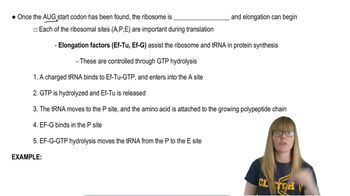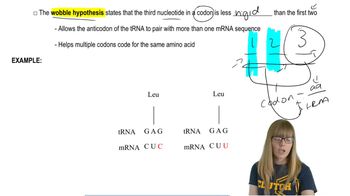Table of contents
- 1. Introduction to Genetics51m
- 2. Mendel's Laws of Inheritance3h 37m
- 3. Extensions to Mendelian Inheritance2h 41m
- 4. Genetic Mapping and Linkage2h 28m
- 5. Genetics of Bacteria and Viruses1h 21m
- 6. Chromosomal Variation1h 48m
- 7. DNA and Chromosome Structure56m
- 8. DNA Replication1h 10m
- 9. Mitosis and Meiosis1h 34m
- 10. Transcription1h 0m
- 11. Translation58m
- 12. Gene Regulation in Prokaryotes1h 19m
- 13. Gene Regulation in Eukaryotes44m
- 14. Genetic Control of Development44m
- 15. Genomes and Genomics1h 50m
- 16. Transposable Elements47m
- 17. Mutation, Repair, and Recombination1h 6m
- 18. Molecular Genetic Tools19m
- 19. Cancer Genetics29m
- 20. Quantitative Genetics1h 26m
- 21. Population Genetics50m
- 22. Evolutionary Genetics29m
11. Translation
Translation
Problem 15c
Textbook Question
The three major forms of RNA (mRNA, tRNA, and rRNA) interact during translation.
Which of the three types of RNA might you expect to be the least stable? Why?
 Verified step by step guidance
Verified step by step guidance1
mRNA (messenger RNA) is typically the least stable of the three major forms of RNA.
mRNA's primary role is to carry genetic information from DNA to the ribosome, where proteins are synthesized.
The transient nature of mRNA is crucial because it allows cells to quickly respond to changes in the environment by altering protein production.
Unlike tRNA and rRNA, which have more stable secondary structures and are involved in the translation process for longer periods, mRNA is rapidly degraded after its message is translated.
The instability of mRNA is due to its single-stranded structure and the presence of ribonucleases in the cell that degrade RNA molecules.
Recommended similar problem, with video answer:
 Verified Solution
Verified SolutionThis video solution was recommended by our tutors as helpful for the problem above
Video duration:
2mPlay a video:
Was this helpful?
Key Concepts
Here are the essential concepts you must grasp in order to answer the question correctly.
Types of RNA
There are three major types of RNA involved in protein synthesis: messenger RNA (mRNA), transfer RNA (tRNA), and ribosomal RNA (rRNA). mRNA carries the genetic information from DNA to the ribosome, tRNA transports amino acids to the ribosome for protein assembly, and rRNA forms the core structural and functional components of ribosomes. Understanding these roles is crucial for analyzing their stability during translation.
Recommended video:
RNA Stability
RNA stability refers to the lifespan and integrity of RNA molecules within the cell. Factors influencing RNA stability include the presence of secondary structures, the type of RNA, and the cellular environment. Generally, mRNA is less stable than rRNA and tRNA due to its role in transiently conveying genetic information, which requires it to be rapidly synthesized and degraded.
Recommended video:
Translation Process
Translation is the process by which ribosomes synthesize proteins using the information encoded in mRNA. During this process, tRNA molecules bring specific amino acids to the ribosome, where rRNA facilitates the assembly of these amino acids into polypeptide chains. The dynamic nature of translation contributes to the varying stability of the different RNA types, particularly mRNA, which is designed for short-term use.
Recommended video:
Guided course

mRNA Processing

 7:58m
7:58mWatch next
Master Translation initiation with a bite sized video explanation from Kylia Goodner
Start learning





